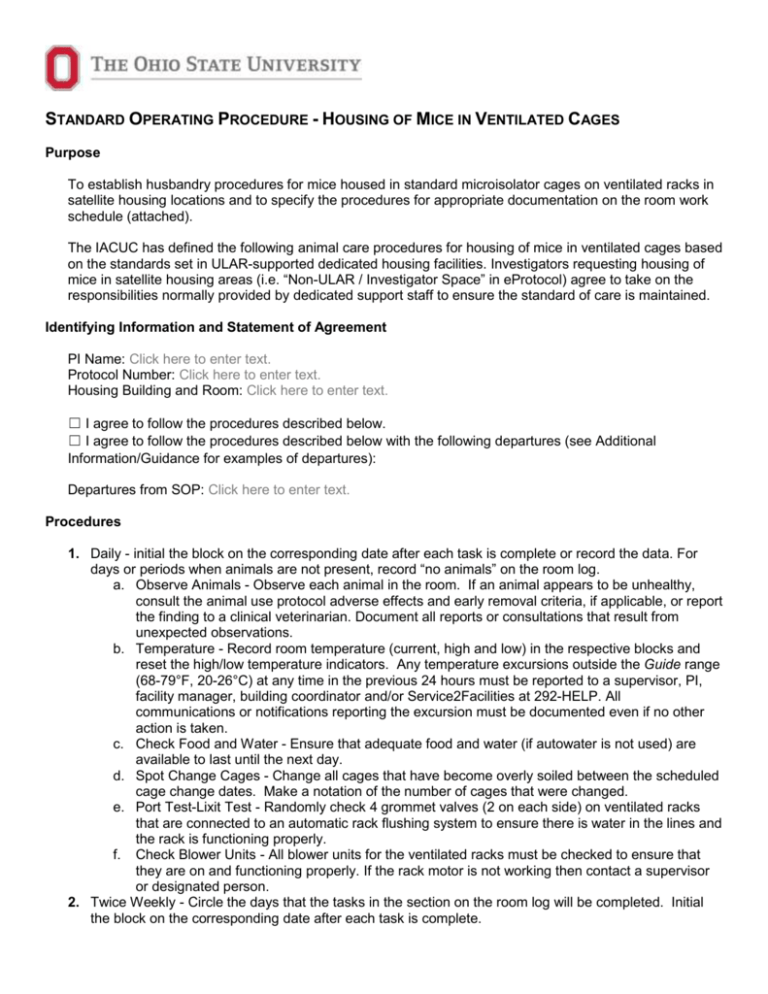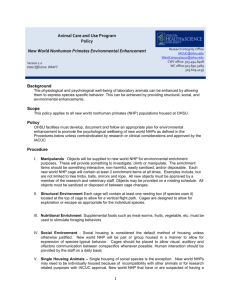SOP - Office of Responsible Research Practices
advertisement

STANDARD OPERATING PROCEDURE - HOUSING OF MICE IN VENTILATED CAGES Purpose To establish husbandry procedures for mice housed in standard microisolator cages on ventilated racks in satellite housing locations and to specify the procedures for appropriate documentation on the room work schedule (attached). The IACUC has defined the following animal care procedures for housing of mice in ventilated cages based on the standards set in ULAR-supported dedicated housing facilities. Investigators requesting housing of mice in satellite housing areas (i.e. “Non-ULAR / Investigator Space” in eProtocol) agree to take on the responsibilities normally provided by dedicated support staff to ensure the standard of care is maintained. Identifying Information and Statement of Agreement PI Name: Click here to enter text. Protocol Number: Click here to enter text. Housing Building and Room: Click here to enter text. ☐ I agree to follow the procedures described below. ☐ I agree to follow the procedures described below with the following departures (see Additional Information/Guidance for examples of departures): Departures from SOP: Click here to enter text. Procedures 1. Daily - initial the block on the corresponding date after each task is complete or record the data. For days or periods when animals are not present, record “no animals” on the room log. a. Observe Animals - Observe each animal in the room. If an animal appears to be unhealthy, consult the animal use protocol adverse effects and early removal criteria, if applicable, or report the finding to a clinical veterinarian. Document all reports or consultations that result from unexpected observations. b. Temperature - Record room temperature (current, high and low) in the respective blocks and reset the high/low temperature indicators. Any temperature excursions outside the Guide range (68-79°F, 20-26°C) at any time in the previous 24 hours must be reported to a supervisor, PI, facility manager, building coordinator and/or Service2Facilities at 292-HELP. All communications or notifications reporting the excursion must be documented even if no other action is taken. c. Check Food and Water - Ensure that adequate food and water (if autowater is not used) are available to last until the next day. d. Spot Change Cages - Change all cages that have become overly soiled between the scheduled cage change dates. Make a notation of the number of cages that were changed. e. Port Test-Lixit Test - Randomly check 4 grommet valves (2 on each side) on ventilated racks that are connected to an automatic rack flushing system to ensure there is water in the lines and the rack is functioning properly. f. Check Blower Units - All blower units for the ventilated racks must be checked to ensure that they are on and functioning properly. If the rack motor is not working then contact a supervisor or designated person. 2. Twice Weekly - Circle the days that the tasks in the section on the room log will be completed. Initial the block on the corresponding date after each task is complete. 3. 4. 5. 6. a. Flush Autowater Racks - All racks must be flushed twice per week. Open the flush and flow water valves. Once the water flow had been observed close the flow valve. Let the water continue to flow for approximately 3 minutes then close the flush valve. Weekly - Initial the block on the corresponding date after each task is complete. a. Change Water Bottles (if used) - Water bottles must be changed weekly with bottles that have been sanitized in the tunnel washer or cage washer (i.e., do not refill bottles from a faucet). Every Two Weeks - Initial the block on the corresponding date after each task is complete. a. Change Cages/Sweep Floors - All cages on ventilated racks must be changed every two weeks. Prior to moving animals to a new cage the cage must be charged. This is done by placing the new cage in the charging station then pushing the cage back until it connects with the water grommet. Once the cage is docked move the lixit in a circular motion until there is continuous flow of water from the lixit. b. Change Wire Feeders and Food - Change wires or stainless steel feeders. Dispose of the old food and provide fresh food. Five adult mice eat approximately 315 grams of food over a twoweek period. This equates to approximately one-half of the wire bar lid filled with food with the divider up. c. Replace Extra Enrichment - replace extra enrichment (huts, Nylabone, wheels) provided for all singly-housed or group-housed animals Monthly - Initial the block or record data on the corresponding date after each task is complete. a. Check Humidity - Record the relative humidity. Notify the PI or designated person if the measurement is out of range (30%-70%). b. Check Light Timers - Verify that the light timer is switching on or off at the appropriate time. c. Sanitize Food Storage Container - Return the old container to ULAR for cleaning, throw away the old food, and replace with new food and a new clean storage container. Record the appropriate information on the feed card (i.e., mill date or expiration date and type of diet). d. Sweep and Sanitize Floor - Sweep the floor and mop with 10% bleach solution* to sanitize. e. Check/Change Rack Blower Filters - Visually check filters on the supply and exhaust motors of the ventilated racks. Replace if necessary and note if/when the filters were changed. Filters must be changed a minimum of once every 3 months. f. Provide Census to ULAR - Turn in a paper census to ULAR for all cages that do not have a RFID cage card holder in place. g. Verify Battery Backup on Alarms - Alarm systems with a battery backup must be tested monthly. Every Six Months - Record the last date of completion for each activity on each monthly room log to keep track of when the activities are due again. a. Change Micro Isolator Lids - Replace all micro isolator lids with clean lids. b. Clean Room Exhaust Grill and Filter - Change the filter (in rooms with filters) every six months. Clean the HVAC supply and exhaust grills by wiping clean. c. Verify Alarm System - All environmental alarm systems must be tested/verified semiannually and documentation made available during semiannual inspections. d. Sanitize Ventilated Racks - Ventilated racks, including supply and exhaust hoses, must be sanitized through a cage washer. General housekeeping and husbandry activities in an animal housing location include wiping down all surfaces after cages are opened and animals are handled (whether for cage changes or study purposes), ensuring trash cans are emptied regularly, and keeping the floor clean of feces, bedding or food pellets. Enrichment Standard cage scheme will be social (group) housing in a solid-bottom cage with contact bedding with a nestlet provided. Single housed animals require additional enrichment in the form of a hut, wheel, Nylabone, etc. Information Required to Comply with IACUC Policies Housing Requirements for Animals, states that an environmental alarm system must be activated and in working order for housing with environmental controls. Alternatively, justification for an exemption must be stated in the SOP/SMP. Recommended alarm set points for housing of mice are LOW = 65° F, HIGH = 80° F. Please indicate the set points that will be used in this location, or provide justification for exemption from an alarm below: Low temperature set point: High temperature set point: Justification for exemption: Click here to enter text. Validate the Effectiveness of Manual Sanitation, states that for manual sanitation of primary enclosures (all items that come into direct contact with the animal during housing such as cages, wire feeders, enrichment devices, water bottles) the disinfectant, contact time and dilution must be included in the SOP/SMP for the housing area and the process must be validated on a semi-annual basis. The recommended sanitation procedure is via facility tunnel/cage wash, for which validation is already provided by ULAR. Please select one of the following options for sanitation of primary enclosures: ☐ All primary enclosure items will be sanitized in ULAR-maintained tunnel/cage wash. ☐ The following primary enclosure items will be manually sanitized. The following disinfectant, contact time and dilution will be used (see Table 1: Hard-Surface High-Level Disinfectants for guidance and recommendations) and the process will be validated every six months: Items to be sanitized and description of procedure: Click here to enter text. Instructions for Uploading to eProtocol After completion of the required sections above, please save this file as a pdf with the document title in the format “Protocol Number (Pi last name) - Building Room Number” (e.g. 2010A00000512-R1 (Smith) - BRT 120) and upload the file into eProtocol in the housing location request. Applicable Regulations 1. National Research Council Guide for the Care and Use of Laboratory Animals, Eighth Edition. National Academy of Sciences, 2011 2. IACUC Policy - Housing Requirements for Animals 3. IACUC Policy - Validate the Effectiveness of Manual Sanitation 4. IACUC Policy - Reporting of Temperature Excursions in Animal Housing Locations 5. IACUC Policy - Documentation of Husbandry Procedures Additional Information/Guidance 1. Investigator Guidance: Housing of Animals Best Practices 2. Investigator Guidance: Temperature Excursion Reporting Log 3. * See Table 1: Hard-Surface High-Level Disinfectants for other acceptable disinfectants that may be used in lieu of 10% bleach. 4. Possible examples of departures from SOP: a. Single-housed animals do not receive extra enrichment besides a nestlet and corncob bedding, so the statement about enrichment does not apply. (Be sure to include justification for withholding extra enrichment in the designated area in eProtocol) b. Animals are exposed to ambient light, or the light cycle is controlled manually, so item 5.b. in the procedure list does not apply c. Justification has been provided (detailed on page 2) for exemption of an environmental alarm d. Animals are housed in metabolic cages with wire bottom and no nestlet e. Animals are housed at temperatures above/below Guide recommended range for specific research purposes f. Other - contact iacucinfo@osu.edu with questions about other items that might be considered a departure from the SOP







